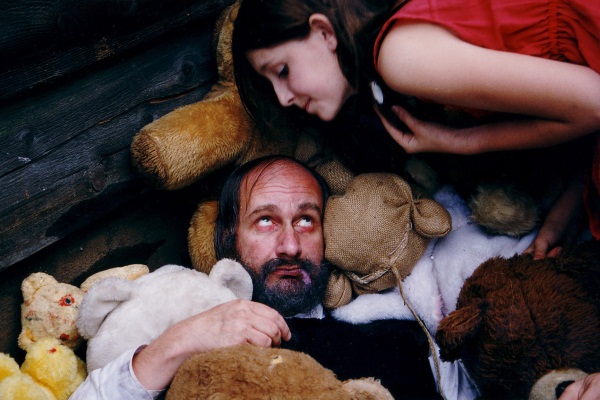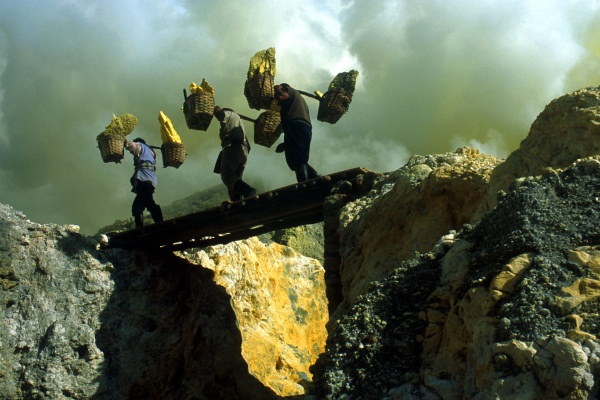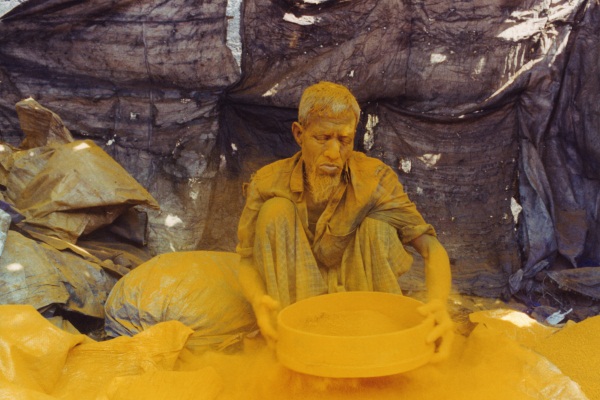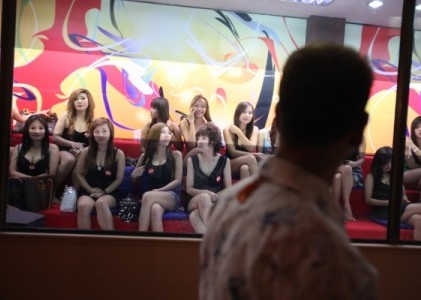The World Viewed, Part 1
The following text, translated by Kurt Beals, is an excerpt from Olaf Möller's forthcoming book on Michael Glawogger, Weltwärts (Worldwards). Part 2 can be found here.
***
An Example: Praying man (Karachi, Pakistan)
A small shop in the market district. A street where only sewing machines are sold, and right next door, the largest mosque far and wide. Butchers sometimes dump their scraps in the adjacent park in the evening, and then the air is full of vultures. The mosque glows in the background in green fluorescent light.
Between the sewing machine shops and the mosque is one other store: a small, impeccably clean Nissan showroom. It has room for exactly one car. The car is gray, a radiant gray. There's just enough space between the showroom window and the car for a prayer rug, laid at an angle. The salesman interrupts his work to pray there. He is wearing gray clothes and a white-gray cap. He kneels in front of the car with his body erect and his hands at chest height, palms facing upward to receive Allah's mercy.
With this picture, which was never taken, I would like to send you into the world of this film.
This description presents a moment of reality—with all its contradictions, comedy/tragedy, concrete political presence—an image that has been seen, experienced, but never committed to film, fixed, made available for discussion or contemplation. This moment is found in the treatment for Untitled—The Film Without a Name (written 2011), Michael Glawogger's current project, which he intends to realize soon with Attila Boa, one of his longtime cameramen. Glawogger doesn't have time to rest; there's too much life out there that he's yearning for... In Untitled—The Film Without a Name, there will be a place for all the things that are normally lost in the process of making a film—everything that's seen, experienced, that tells us something about existence on earth, but that has nothing to do with the topic of the current project. It will be the antithesis of the normal documentary film: because it isn't about anything, it can be open to everything. I've always found [the demand for a topic] to be a restriction. The real storyteller takes the whole world as his topic, and can create something out of whatever he comes across that seems worth telling, as Glawogger puts it in the treatment for Untitled—The Film Without a Name.
In the end, of course, there will be more pictures left untaken than images that make it into the film, which Glawogger and Boa estimate will run about three hours—the struggle to capture the world in its totality will always end in a Pyrrhic victory. That's how it is for Glawogger: freedom and failure are one and the same, as shown by his two projects about filmmaking, Movies in the Mind (1996) and Slugs (2004). Only someone who is willing to make a fool of himself by striving for something, longing for something, believing in something greater, different, more beautiful, more worthy than the status quo, can actually get somewhere. So Glawogger's films are all milestones in his journey through the time that he has been granted.

Movies in the Mind
There are some things that are unlikely to turn up again in Untitled—The Film Without a Name, either because they're simply not around anymore, or because something else has pushed its way into Glawogger's life: the highwaymen between Abua and Jos, armed with gigantic toothbrushes; the hookers in Kano, six-and-a-half feet tall on average, who laugh about the little white man and can't take him seriously as a man; the whores at the end of Siberia, in the ruins of the Gulag Archipelago, that kingdom of the dead from the stories of Varlam Shalamov, who trudge through the deep snow in their impossible platform boots; the women who work on a factory boat that fishes for crabs off the coast of Kamchatka Oblast, hundreds of women working in tandem in a cramped space, a sight that seems to come from the era when Takiji Kobayashi wrote his novel Kanikosen (1929), a classic of Japanese revolutionary literature that takes place aboard the same kind of floating coffin; the miners and foremen in gold mines from Brazil to South Africa; the tanks that roll through the streets day after day in Reynosa in the war between the Federales and the drug mafia.... At least none of these places, situations, or (remembered) images appear on the travel itinerary included in the treatment for Untitled—The Film Without a Name. The itinerary folds out; at the top is a very stylized map of the world made up only of billiard-ball-style points, with a rough description of a route full of seductive city names—from Austria the trip will take him through Scandinavia, Russia, East Asia, the U.S.A., Central and South America, South, East, Central, and West Africa, the Middle East, Southeast Europe, and finally back to Austria. Beneath this itinerary are a few facts, i.e., possible stories pertaining to these places. According to this description, the film could include things like the following: the collective scream that takes place every Tuesday at 10 p.m. in the Läappkrrsberget dormitories in Stockholm; the Mercado de los Mineros in Potosi, where dynamite is sold alongside cabbage and pears; the nightly feeding of the hyenas at the gates of Malapati; the churches of Asenovgrad; the city Kukës, whose residents were collectively nominated for the Nobel Peace Prize in 2000 for taking in half a million refugees during the Kosovo conflict (it went to Kim Dae-jung)...among other things. There's always something happening, if you want to see it and hear it—the world is there if you want it.
***
As of this writing (summer 2011) Michael Glawogger is preparing for the world premiere of Whores' Glory (2011) at the 68th Mostra Internazionale d'Arte Cinematografica. The film is sure to generate a lot of interest [editor's note: it won the Special Jury Prize in the Orizzonti section], since Whores' Glory is the latest film from the director of Megacities (1998) and Workingman's Death (2005), two of the most widely discussed and most aesthetically successful documentaries of recent decades. Of course, Glawogger is also the auteur of films like Slumming (2006), Kill Daddy Good Night, and Contact High (both 2009), three of the most fascinating feature films of the same period, works of rare subversiveness; but this is generally seen as a side note or even a minor contradiction, since we all know that Michael Glawogger is a documentary filmmaker.
Clichés take shape quickly and fade away slowly, and they can impact—i.e., impair—the reception of an artist's work for decades.1 Glawogger, for instance, is still seen as a documentarian who sometimes makes feature films too, even though his oeuvre actually includes more of the latter. Among his feature-length works, four clearly nonfictional films—Megacities, France, Here We Come! (1999), Workingman's Death, and Whores' Glory—rub shoulders with five feature films—Ant Street (1995), Slugs, Slumming, Kill Daddy Good Night, and Contact High—as well as two works—War in Vienna (1989; with Ulrich Seidl) and Movies in the Mind—that boldly defy any categorization. Glawogger at one point cautiously identified these last films on his website as "docudramas," knowing full well that this term doesn't really apply, it's just that the category "film without a genre" doesn't exist yet.
What's clear is that Glawogger's feature films would have developed very differently were it not for his documentaries, as he himself always acknowledges, and vice versa—there's a clear symmetry, the forms inform each other and fertilize each other, as well they should. In an extreme case, the plot of a feature film might unfold in reality, that is, in the creation of a documentary film. Whores' Glory is one of these cases: on close examination, it can be seen in part as the product of Glawogger's grappling with William T. Vollmann's Butterfly Stories (1993). Glawogger had been trying since the late '90s to adapt this novel into a film called Butterfly Boy. By 1999 the first draft was ready, and Michael Madsen (one of Dennis Hopper's favorite poets) was being considered for the lead. But somehow it didn't work out, and the project ran aground in 2002—with one new detail: it was now called lovesick. Since then, Glawogger had learned so much—about himself, among other things—that his own experience had "moved beyond" large parts of the script. This wealth of experience gave rise to the film Whores' Glory, as well as a photo-text (in Wright Morris's sense), i.e., the book of the same title that accompanied the film. The title is a reference to another work by Vollmann, Whores for Gloria (1991), that Hopper optioned for a film a few years before his death, in which a man searches for love and other uncertainties among prostitutes. What could lovesick have made out of Butterfly Stories that isn't already told, or experienced, in Whores' Glory? The story of the traces of wars (Indochina, Vietnam), and of everything that state terrorism makes of/with people, makes them do/suffer.
Glawogger always says that he mainly turned to documentary film in order to be able to keep producing at all. His bizarre, eccentric Ant Street—a Vienna comedy that still bore the strong influence of his film school friend Ulrich Seidl in many of its directorial details—had slipped away from him in the execution; the production was apparently a fiasco, though this isn't immediately clear from the film itself. Meanwhile, Movies in the Mind, his visionary examination of the reality of film—its basis in people's everyday lives, dreams, discontents, sorrows, and fears—was a failure at the box office and suffered at the hands of critics, to put it mildly. It looked like his career was headed for a sudden end. What he needed was a comparatively inexpensive production, and the result was Megacities; sounds plausible. But that's not exactly how it happened: in fact, Glawogger always had a strong interest in documentary as well as fictional film, and particularly in the combination of these forms. Not to mention in experimental film, which has often been forgotten or overlooked, since there's nothing in Glawogger's works since his early student film Pacific Motion (1981) that clearly belongs in this category. At the same time, though, his works are full of gestures, strategies, and tropes borrowed from (more) radical filmmaking, such as (to name just one small, playful example) the cat's head that Glawogger digitally pastes onto Lenin's body in a scene from Eisenstein's October (1928), an accidental homage to Andrey Silvestrov and Pavel Labazov's insertion of Vladislav Mamyshev-Monroe into Grigori Aleksandrov's Volga-Volga (1934/2006). Good and evil are just God's own prejudices (to paraphrase Helmut Eisendle), and so, likewise, are feature films, documentaries, and experimental films just stereotypes of the film industry—they have nothing to do with film itself, or with life. Glawogger is concerned with the theatricality of the everyday—Praying Man (Karachi, Pakistan)—the ways that our conceptions of the world exist alongside its reality, and how these two things sometimes, sometimes, coincide or overlap, or perhaps only appear to.2 Feature film for him means fiction animated with worldliness, with the knowledge that comes from experience; documentary means putting the production itself onscreen.

Workingman's Death
Megacities, for instance, the work that made Glawogger famous with a single stroke, though perhaps not for the reasons he would have preferred, is a symphony of civilization built out of images and sounds found and constructed in Mumbai/Bombay, Ciudad de México, Moscow, and New York City. It is often seen as a study of immiseration, though in reality, it is at least as much a film about the perception—Glawogger's perception—of the world. What frustrates many people about this film, and about Workingman's Death and Whores' Glory, which adhere to a similar principle, is Glawogger's refusal to approach these topics with a well-meaning, accusatory gaze. Like Vollmann (whose 1996 novel The Atlas describes the world like Megacities sees it), he doesn't aim to unsettle the good bourgeois conscience with images of suffering and desperation. Instead, he views these lives as such, their own value, which is different from the value usually assigned to them by the pitying gaze of charities, and their beauty, in plastic and blood, frippery and flesh. Some critics clumsily accuse Glawogger of exploitation for his fascination with the often extreme poetry of his subjects: in Megacities, the stripper Cassandra, who lets her spectators and admirers lick her pussy onstage; in Workingman's Death, the proud butchers of Port Harcourt and the sulfur miners of Kawah Ijen. They seem to think that whatever shouldn't be, can't be: for instance, an archaic form of communion, a cross between sublimated cannibalism and ecstasy, or joy in the mastery of the handiwork of death, a red radiance in the cadavers and pools of blood. But what seems to offend them the most is not so much the subject itself, but rather the beauty that Glawogger finds in it. If it all looked terrible, that would be okay, but it sparkles and glistens, sometimes even gleams, and that's when people get uncomfortable. It has to be true, because it's beautiful, but if it's beautiful, then it has to be good, too. In response to that, Glawogger would just cite Johann Wolfgang von Goethe's Epirrhema (1827):
You must, when contemplating nature,
Attend to this, in each and every feature:
There's naught outside and naught within,
For she is inside out and outside in.
Thus will you grasp, with no delay,
The holy secret, clear as day.
Joy in true semblance take, in any
Earnest play:
No living thing is One, I say
But always Many.
Megacities and Workingman's Death left only a few obvious traces in Glawogger's feature films. Without the latter, Slumming wouldn't have its end in Indonesia; without the former, Contact High would be lacking its scenes in Mexico, and Kill Daddy Good Night might not have the slick New York Internet entrepreneur. Of course, these films still would have taken place somewhere, but maybe not there, and who knows how these scenes would have looked and felt without their documentary antecedents. And even this demimonde character would have turned up one way or another, but he certainly wouldn't have been the same.

Megacities
More often, though, the influences are subliminal: Kallmann, the aimlessly wandering poet in Slumming, for example, was inspired by someone Glawogger kept running into while working on France, Here We Come! Kallmann the ballman didn't find a place in that film, but Glawogger kept him in the back of his mind, and eventually transformed him into the figure in Slumming. This sort of transformation—the central theme of Contact High—can be observed throughout Glawogger's oeuvre. For Workingman's Death, he visited a shipbreaking yard in Bangladesh, but ended up filming the scene in Pakistan; but Bangladesh suddenly comes up in the dialogue in Slumming. In Whores' Glory, Glawogger finally filmed in Bangladesh—the place and the experiences apparently lingered in his head until he found a way to transform them into sounds and images. To name another example, this one somewhat simpler and more immediately visible in the films: the deer. In Slugs, the deer is one of many creatures that appear to the stressed-out amateur pornographers. In Slumming, it first appears as a tattoo on a young woman's thigh, then as a sort of vision before Kallmann as he tramps through the deep snow in a forest, and finally, at the end, it appears before Kallmann's eyes again, leaping through wintry Vienna. Finally, in Kill Daddy Good Night, a deer is killed in a car accident—and with that this symbolic chain comes to an end. Another fascinating transformation would take place if Glawogger were to finally realize his intended porno remake of Slugs. In this film, a cheetah appears again and again to the characters, and they often discuss how they'd like to have animalistic "cheetah sex"; in the porno version, there would be a character made up like a cheetah, filming the gang-bang for an ecstatic conclusion: A cheetah man sits on the roof of the house. Naked. His whole body is tattooed with a fur pattern. He films the small group in the garden. They've completely forgotten about him. He purrs as he watches, and finally hisses like a wildcat.
1. Glawogger's early model, Werner Herzog, had to struggle with similar problems of perception: until the late '80s, he was seen primarily as a feature film director who also made documentaries on the side. Since the early 2000s, on the other hand, he has been discussed primarily as a documentarian who also occasionally tries some fiction. Symptomatic of Herzog's situation is the reception of his stubbornly under-noticed war film Rescue Dawn (2006), which is based on an episode from the life of Dieter Dengler, who was already the subject of Herzog's portrait Little Dieter Needs to Fly (1997) nine years earlier. We tended to give preference to the latter film, because Dengler's character and his life were already so crazy that Christian Bale's formidable crypto-Kinski-esque performance was hardly necessary... that's what we said, on average. Later, in Cave of Forgotten Dreams (2010), some of us took issue with the albino alligator coda, which they thought was superfluous, simply too fanciful—either ignoring or just not understanding that this is exactly where the film arrives at its point: namely, how strange it is to create images for the future, and how poignant it is that we feel this need.
How disturbingly wondrous this idea is: a gathering of radiantly white alligators watching a film, marveling in their own way about what mysterious creatures these people were who once existed; then one or the other starts to wonder what will come after them, and how those creatures will respond to their reptilian ways of passing on experiences, insights, and perspectives.
2. This reading is supported by a look at Glawogger's website, mentioned above. Looking carefully at the filmography there, which leaves out many small, early works, one quickly notices that the order of two titles has been reversed—here War in Vienna is followed directly by Movies in the Mind, with Ant Street following, though the correct years are given. This seems to imply that the docudramas were a discrete block of work, a creative period, and that only the production process, the way that things developed, sort of messed that all up a bit... ![]()
LATEST ARTICLES
-20140814-173707-thumb3.jpg)
Fighting Words
by Imogen Sara Smith
posted August 12, 2014

Fighting Words, Part 2
by Imogen Sara Smith
posted August 20, 2014

On the Margins: The Fil…
by Andrew Chan
posted August 12, 2014

Robin Williams: A Sense…
by David Schwartz
posted August 12, 2014




